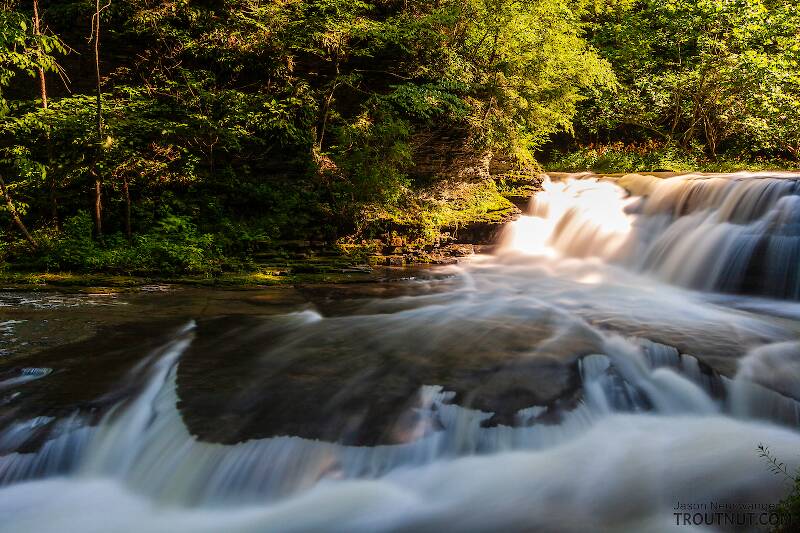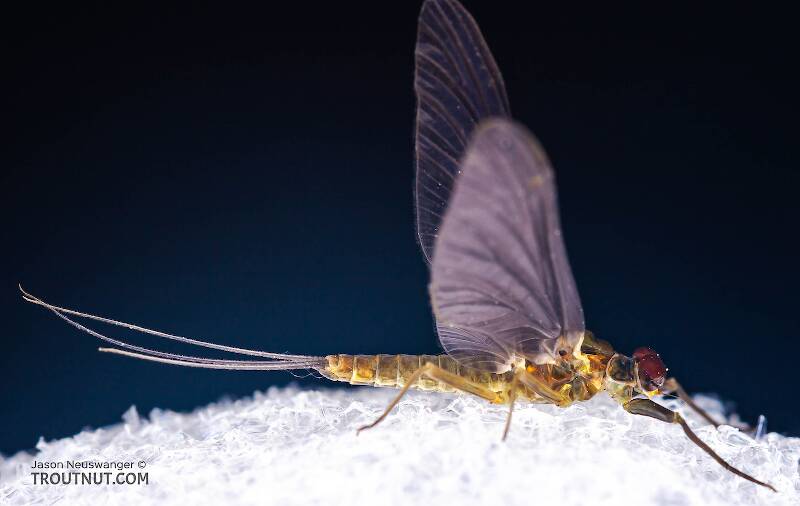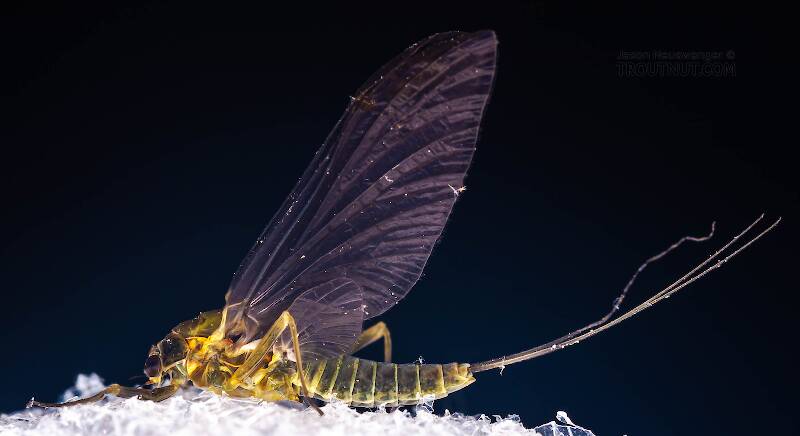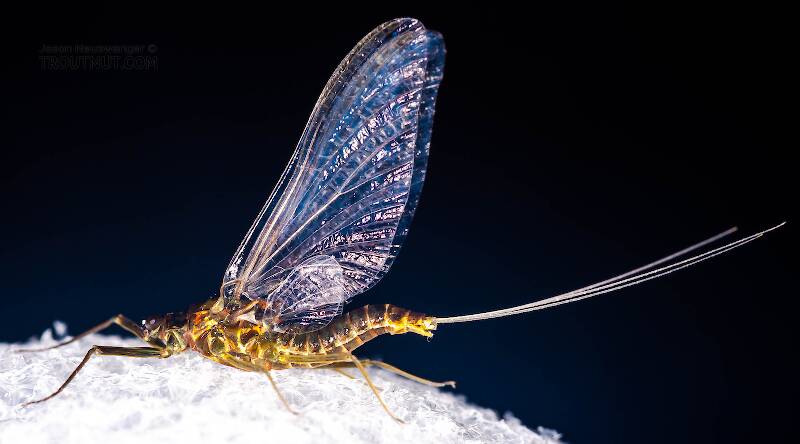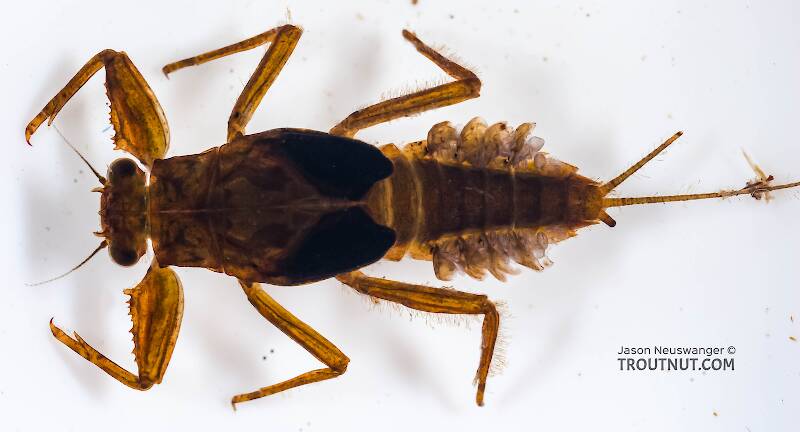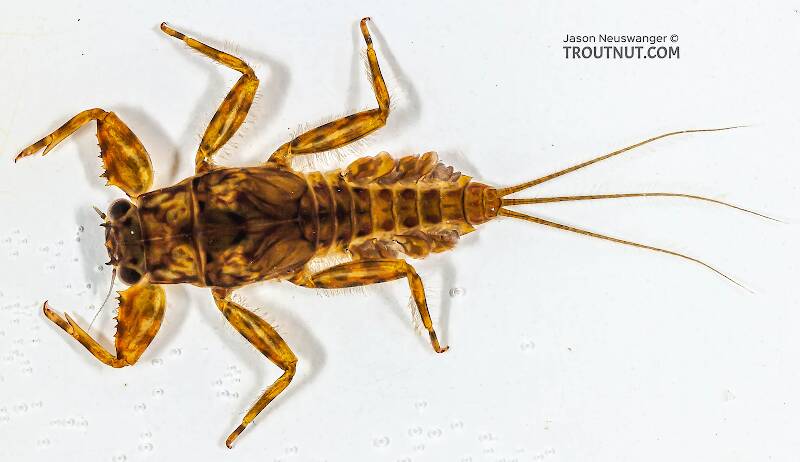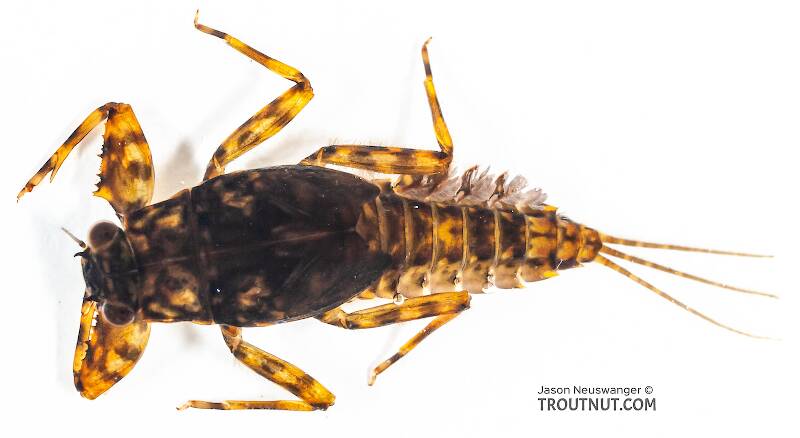
Salmonflies
Pteronarcys californica
The giant Salmonflies of the Western mountains are legendary for their proclivity to elicit consistent dry-fly action and ferocious strikes.

Mayfly Species Drunella cornuta (Large Blue-Winged Olives)
Lloyd Gonzales, in his book Fly-Fishing Pressured Water, notes that this attractive olive-green mayfly can provide good-to-excellent morning fishing in the faster sections of many streams. He also mentions that it can hatch in surprising numbers and usually faces less competition for the trout's attention than many of the spring or evening-emerging ephemerellids. Yet, cornuta and its sister species have largely escaped the limelight. The renowned twilight hatches of big Ephemera drakes and many other popular mayfly species command fly fisher's attention at this time of year. As the days lengthen, fishing all of the available mayfly hatches would require a pretty long day astream, so most anglers choose to focus on the late afternoon and evening activity.
Nature seems to have several recurrent color themes, and one of these is gray-winged/olive-bodied aquatic insects. Perhaps this explains why the name "Blue-Winged Olive" is often held up as the poster child for common name confusion. It has been freely applied to a multitude of mayflies in various families, genera, and species. Prior to having a well-established common name, this mayfly was referred to by Gonzales as the Olive Morning Dun. However, it has already been added to the long list of "BWOs" on many Eastern/Midwestern hatch charts.
Species Range
Hatching behavior
Spinner behavior
Time of day: Evening, sometimes early morning
Habitat: Riffles
Juvenile biology
Current speed: Moderate to fast
Substrate: Cobble, mixed aggregate
Environmental tolerance: Perhaps less tolerant than some Ephemerellidae species, Gonzales notes that populations have declined or virtually disappeared from streams that have been impacted by the release of untreated sewage.
Identification
To determine whether a specimen of Drunella belongs to Drunella cornuta, use the Key to Species of Drunella Nymphs.
Drunella cornuta Fly Fishing Tips
Many standard "BWO" mayfly dun and emerger patterns in size 12-16 can work well during the emergence, though the brighter (nearly chartreuse) body color of freshly emerged duns can be worth imitating at times. Rises in fast water can be dramatic and splashy, much like the rises to some emerging caddisflies. "Dead-drifted" nymph imitations work very well before, during, and even after the emergence. Although Drunella nymphs are rather awkward swimmers, swimming nymphs can be very effective where faster water breaks into pools or eddies.Physical description
Most physical descriptions on Troutnut are direct or slightly edited quotes from the original scientific sources describing or updating the species, although there may be errors in copying them to this website. Such descriptions aren't always definitive, because species often turn out to be more variable than the original describers observed. In some cases, only a single specimen was described! However, they are useful starting points.
Male Spinner
Wing length: 9-11 mm
A species of the fuscata group (now a synonym of Drunella walkeri) allied to both E. cornutella (now a synonym of Drunella cornutella) and E. longicornis (now a synonym of Drunella longicornis); third forceps joint of the male relatively longer, and the second joint more strongly bowed, than in its immediate allies.
Head and thorax blackish brown. Pleural sutures, an area anterior to the wing root, and the antero-lateral margins of the mesonotum paler, with ruddy tinges. Femur and tibia of fore leg blackish brown, tarsus smoky brown. Middle and hind legs yellowish amber to olive brown. Hind femur very slightly longer than the tibia. Axillary cords extend backwards slightly beyond the scutellum, ending in blunt lobes. Wings hyaline, venation pale; the main veins of the costal margin often tinged with yellow basally, becoming yellowish brown apically. A brown spot at the base of the subcosta in the fore wing. Abdomen reddish brown dorsally and ventrally, the posterior segments darker; middle segments often with very narrow pale margins. Pleural fold may be narrowly pale. In some specimens there are faint traces of pale mid-dorsal and submedian streaks, pale ventral ganglionic areas and short brown submedian oblique streaks from the anterior margins. Tails pale yellowish. Our local form is slightly larger and paler than the one from Quebec. Specimens of the variety from North Carolina have wider pale areas on the abdomen; the abdominal tergites have darker transverse median bands and dark posterior margins; venation pale brown; tails purplish brown, size slightly larger than the New York form.
Described as E. depressa
Body length 6-7 mm, wing length 10-11 mm
A species of the fuscata group; very close to E. cornuta (perhaps it is synonymous with that species). Male imago not known. Female separated from that of cornuta, in original description, by the usual but not constant fusion of vein M and Cu1 in the fore wing. Nymph said to be distinguished from that of E. cornuta by the shape of the maxillary palp and the fore femur. From the illustrations, we can find no good distinguishing character for the nymphs of the two species. Further, the venational character mentioned is one which occurs occasionally in several species of this group, and is apparently constant in none.
Nymph
Head of nymph with curved frontal horns and a frontal shelf; no occipital tubercles. Thorax smooth. No dorsal abdominal spines. Gills borne on segments 3-7. General color reddish brown, the thorax often mottled with brown. Anterior margin of fore femur bears teeth or spines; the tibial spine or ‘thumb’ curves outward gradually from the base, and does not extend beyond the middle of the tarsus. Tails pale, with a single dark basal ring.
Specimens of the Mayfly Species Drunella cornuta
1 Male Dun
1 Female Dun
1 Female Spinner
3 Nymphs
Discussions of Drunella cornuta
Start a Discussion of Drunella cornuta
References
- Needham, James G., Jay R. Traver, and Yin-Chi Hsu. 1935. The Biology of Mayflies. Comstock Publishing Company, Inc.
Mayfly Species Drunella cornuta (Large Blue-Winged Olives)
Species Range
Common Names
Resources
- NatureServe
- Integrated Taxonomic Information System
- Global Biodiversity Information Facility
- Described by Morgan (1911)

